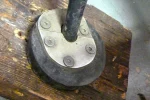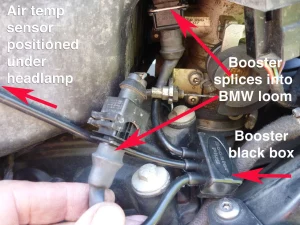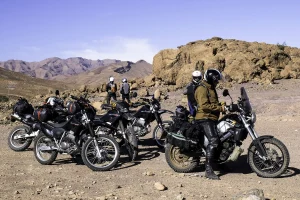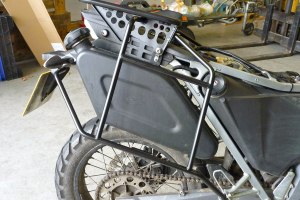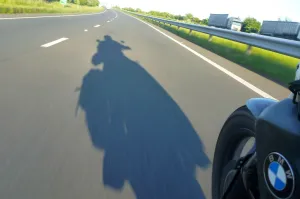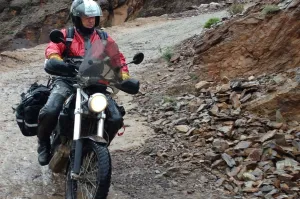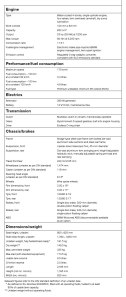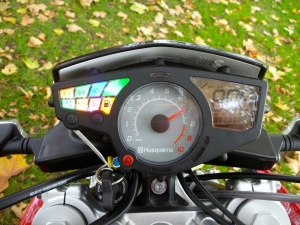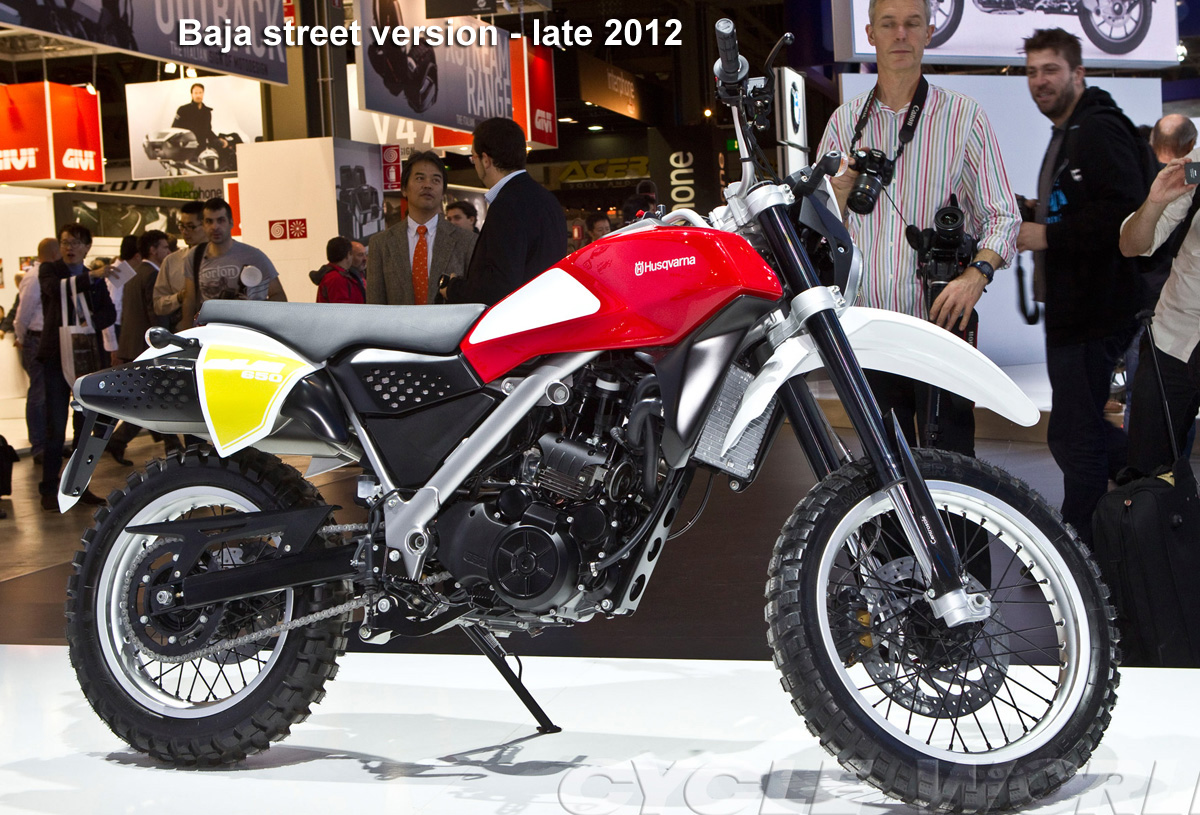XCountry Index of Posts
• Introduction
• Stage 1 mods
• Swapping the subframe
• X-tank and X-rack
• Suspension
• Tutoro chain oiler
• Midsummer update
• The Spanish Plain
The BMW 650X range came and went between 2007-08. They were light and powerful but early reliability issues as well as a high price saw the models sell poorly and then get dropped. After a pause which saw the 800cc parallel twins make their mark, within a couple of years the lardy Sertao and later G650G reset things back to the pre X-bike F650s in terms of weight and performance. Some people think that was a shame.
The bikes from Planet X were a one hit wonder and you get the feeling that the X range – helped in no small way by Walter Colebatch’s extensive Siberian travels and associated development of his XChallenge – might be turning into a cult travel bike, not least due to their limited availability. There’s more on the history of X on the XCo intro index page.
My plans for my XCountry were to run it on a couple of Moroccan tours and maybe take the bike deeper into Mauritania. The later part didn’t pan out this year, but over ten months I racked up 10,000 miles, including 4000 to Morocco and back. I sold it at 16,000 miles.
My XCo set up
Soon after buying it I adapted my X bike as follows (see intro index page for more details on fitting these accessories).
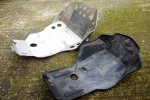 Used Touratech bash plate (right)
Used Touratech bash plate (right)- Used Barkbuster Storms
- Used Spitfire screen (right)
- Full width KTM wheel nuts (right)
- Throttle handrest
- Used Yamaha steel shifter

- Assembled a used tool kit from ebay
- Added a 12v accessory plug on the bars and a DIN plug under the seat for the air pump (Later discovered OE accessory plug near the shock top)
- Replaced alloy subframe with steel unit off a MkII XCo

- Hyperpro 3D shock and progressive HP fork springs and oil change
- Hot Rod Welding Xrack and Xtank
- Hot Rod brake/sidestand protectors (right)
- Adv Spec Magadan II Bags
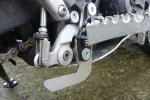
- Booster plug (fuel mixture improver)
- Used RAM mounts on the bars
- Tuturo chain luber
- Wunderlich fender extension
- Used Touratech sidestand foot
All those items I’d fit again without hesitation except maybe the TT side stand plate which fell off in Morocco as I was warned it might. I spotted a better, vibration-proof solution (right) while at Hyperpro. Not totally won over by the Booster plug, but if it runs cooler (richer) and hardly affects mpg then probably worth it.
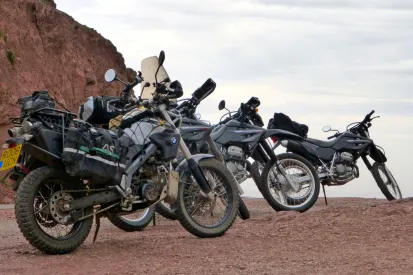
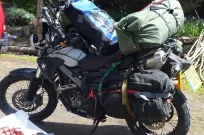
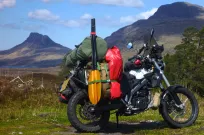
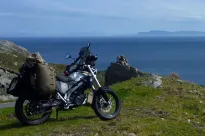
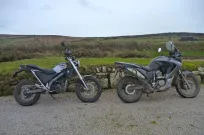
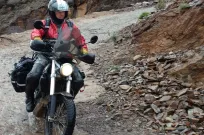
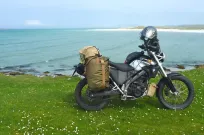
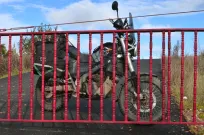


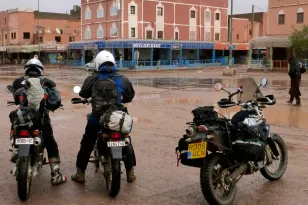

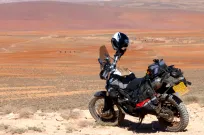
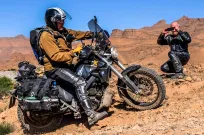
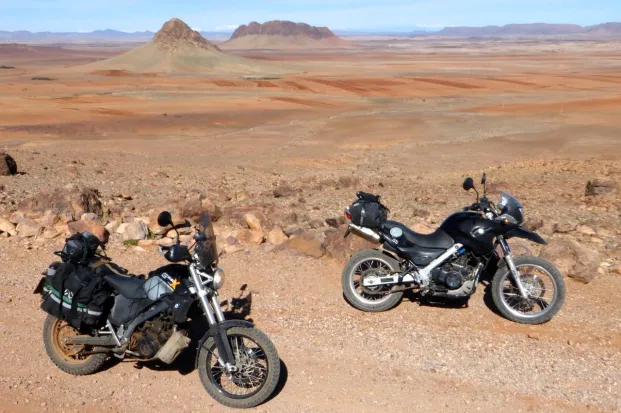
Comfort
When I first sat on the bike I was surprised how small and short it felt and wondered if this might affect comfort. I dare say I may look big on it if I saw myself reflected in a shop window, but at 6′ 1′ and ~92 kilos the XCo proved to be much more comfortable than it looked. By the time I sold it, 700-km days in winter didn’t mean flopping onto a hotel bed exhausted.
Soon after buying it I refitted the small and cheap Spitfire screen from my CRF. There are doubtless better and flashier windshields, but the Spitfire did a brilliant job in keeping most of the wind blast and rain off me. It did this without introducing any handling anomalies at high speeds or in strong winds, nor feeling like it was in the way when riding technical dirt. Fitted on just a pair of stalks clamped to the bars, it didn’t ever budge in all that time. I may well fit it to my next bike.
Following a trip to Scotland, at round 8- or 9000 miles it felt like the foam in the seat had collapsed a little and the pad was less springy. However, that didn’t have any effect on long-day back-end comfort which suggests the shape and profile of the seat works as well as the foam in it. I came off a 750-km day in Spain with no soreness in the limbs or my butt, even if getting off to refuel every 2–3 hours revives the circulation. I also suspect leather trousers – or perhaps any fabric that doesn’t slip on the seat vinyl – extends posterior endurance. This whole experience was the opposite of the crippling seat pf the F650 twin I ran on a similar trip a couple of years ago.
Vibration at cruising speeds was never intrusive, though as with all big singles I’ve had, air-cooled or otherwise, some days at some speeds or engine or ambient temperature or load or fuel quality it feels harsh. I’ve never got to the bottom of it, but as it’s common to big singles it must just be the way they are. My main theory is fuel octane and overall engine temperature.
I bought some Wunderlich bar risers but never got round to fitting them. I had a feeling the added leverage on the rubbery bar mounts might not do them any good. On the dirt in Morocco I was a little stooped when standing up, but not enough to be uncomfortable. Had I also fitted the Hot Rod footrest lowering brackets I would have had a very comfortable standing stance, though I can’t say my legs felt cramped during regular seated riding. Part of the reason was I suspected that lowering the gear lever and brake lever may have been a faff and made them more exposed to damage on the dirt. As it is, on the dirt I tend to sit when I can and stand when I must. The Hyperpro suspension went a long way towards enabling such lazy riding.
The OE cast-alloy gear change lever is light but too strong and is said to transmit shocks to the gear shaft rather than bend. I fitted a folding-tipped steel gear change lever from some Yamaha or other. Although it was identical to the OE unit, it never felt in a natural position for easy gear changes, though the long throw of the clunky gear change doesn’t help.
Although they’ve been around for years I’ve never used a throttle hand rest (or whatever they’re called) but this XCo really benefited from one. The throttle spring must unusually hard. Other’s who rode the bike also commented on the handy hard rest which can be spun out of the way in a jiffy when off-road.
Fuel economy and Booster Plug
Like my Tenere which I ran over similar mileage and use, the fuel consumption on the XCo varied for not always obvious reasons. Twenty four fill ups before the Booster Plug saw an average of 70.5mpg. Worst was 53mpg (18.8 kpl) – the only reading below 60mpg so may have been a miscalculation. The best was 79mpg (27.5 kpl) with a few others in the high 70s, so probably not an error.
With the Booster Plug (~£100, right) I expected slightly worst readings: the average was 67.2 with a low of 56.5 in mid-Spain cruising at up to 70mph (on under inflated tyres, it turned out) and 80.5mpg over the Tizi n Tichka pass in Morocco (the same place my Tenere recorded a similarly high mpg one night). Reading the ambient temperature below the headlight and not in the air box, they say the Booster increases (richness) fuelling on acceleration but levels off back to normal settings at cruising speeds. If Morocco could be said to be less cruising and more accelerating on and off the piste, the lower average is less bad than it looks.
To double-check and to see if I could feel any difference, I unplugged the Booster on the way back. Within a couple of miles tooling round a small Spanish hill town looking an ATM, I’d stalled a couple of times at low speeds; never did that with the Plug. And later, pulling off the motorway to do something, the fan soon came on. The bike was running a little hotter as expected, but two fill ups saw an all time low of 56.5 and 54mpg for no good reason. Can’t think why that was unless the ECU mapping had adjusted to the Booster settings and was over compensating. Apart from the stalling and possibly mpg, I can’t say I detected any genuine difference with the Plug while riding the bike. I replugged the Plug in north Spain. Next mpg was 61.5 – less abnormal.
As is well-known the X bikes come with a 9L tank giving a range of 150 miles/250km -too small to be useful. The 6.7-L Xtank increased this to a comfortable 370 clicks/230 miles at average mpg.
After fitting the Xtank, a couple of times I got outlandishly high readings of over 100mpg when filling only the Xtank which I assumed emptied before the BMW tank. On the second occasion I realised that with both tanks full, the bike probably initially draws some fuel from both tanks, but definitely drains the Xtank first.
So overall the X bike’s average fuel consumption was identical to the F650 twin at 68.3 mpg, and about 5% less than the XT660Z Tenere while being a lighter, lower and more powerful machine (Had I meddled with a similar Booster on the XT it too may have used more fuel.) Click Esso for Xcountry fuel data pdf.
Oil and water consumption; drive chain
I changed the oil to fully synthetic at around 10,000 miles and used about 1.5 litres on the 5000-mile Moroccan run – more than a Tenere, iirc. I was told the bike might consume more oil using fully synthetic. But the bike also felt like it ran better by this mileage, though that may have been the more open, day-long steady riding doing the engine some good. It sure would have been handy if they’d designed the dip stick to be more accessible without removing the seat. And I never really got the whole oil level business: run it till the fan turns on, then walk round the bike three times, turn off and wait two minutes. I’m sure previous dry sump bikes weren’t so fussy (actually they were). Good thing is it’s an oil tank and so has more leeway for running low than a wet sump engine.
One hot summer’s day in London I noticed the coolant level down an inch – it may have been that way for ages. Again, it’s hard to tell the level without carefully peering in the slot. Once I topped it up it never went down again. I’d heard of X bikes suffering mysterious episodes of coolant drop with no actual leaks. The bike will get hot and the fan come on in town or on slow tracks with a backwind, but the fuelling never went off in such conditions, as it did with the F650GS twin in Morocco.
With help from the Tutoro oiler from about 7000 miles, I only adjusted the chain twice in all the time I had the bike and when I sold it at 16k, there was still had plenty in it. Was it these bikes that had chain problems when they came out? Whatever’s on there now is as good as anything.
Performance
The XCo was one of the most powerful 650s around. I imagine a KTM 690 has more poke (but closer gearing?) and the Husky TR650 I rode last gear has five extra hp and certainly sounded more sporty but carried proportionally more weight. There are times on technical dirt when the X power feels too much with the hot engine and pokey response, but of course there are as many other occasions when you blast past a vehicle with assurance. This extra power didn’t seem to affect the fuel consumption or chain and tyre wear, but does make the engine harsher and lumpier than say a Tenere or a docile Sertao/G650G. The fastest I ever went was a true 85mph, briefly. The Xco was happy to sit at a true 65-70mph (75 indicated).
The brakes feel pretty ordinary but there was only a small single disc up front. The front pads were going by the time I sold the bike so lasted at least the 10,000 miles I had the bike, maybe more. The back wore very quickly – at 9000 miles they were gone and I didn’t notice till I damaged the disc. A used rotor off ebay.de was £30. ABS works fine. I never had to rely on it on the road and on the dirt it could be forced to actuate, but in a useful way. I don’t see the need to turn off ABS for the sort of dirt riding I do.
Suspension
On the road, initially the OE suspension felt pretty good and firm compared to Jap bikes and considered it had been a BMW Off Road School bike. Best thing was the easy-to-use knob on the Sachs shock though on the front the UPD forks are unadjustable.
But what works OK riding UK roads may come up short loaded on the piste. After just a couple of thousand miles the rear Sachs gave out no matter how high I cranked the knob. Various options existed to re-spring the back end including rebuilding the Sachs unit for about £120 while maybe adding a firmer or progressive spring. That’s probably the route I’d have taken but for an intro from Walter Colebatch to Hyperpro suspension in the Netherlands. I rode over and got the full custom set up from Bas at the HP workshop. The full story is here but there are more or less three levels of shock: a progressive spring replacement; an emulsion shock and spring; and the full-on gas-charged, remote reservoir, preload, compression and rebound adjustable version.
That was what Bas did for me, along with a fork oil and progressive fork spring replacement, chrome slider polish and neoprene gaiters plus a new headset which had gone in an incredible 7000 miles?!
It was only months later when I experienced the real benefits of the custom Hyperpro set up while battling with five other bikes over an abandoned old track up the Jebel Timouka in southern Morocco. The difference is control: correctly tuned suspension responding predictably to riding over football-sized rock cubes without bottoming out. Although the Desert Riders Honda XRL was notably better sprung than the XTs I’d used up till then, I’ve never had the luxury of a properly suspended machine. And certainly on the dirt I can now see the value.
I bought a chunky and adjustable 48mm DRZ400 fork (right) but never got round to fitting it so assumed the reworked OE UPDs would be ill-matched with the full-on 461 back shocker. But over the Jebel and on other tracks the fork responded predictably and the whole bike felt well-balanced. At the bottom of this must be the progressive springing front and rear and the shock’s adjustable damping. Progressive is nothing unique to Hyperpro but it works in using the near-full range of movement without bottoming out. That and the hydraulic preload adjuster knob similar to the OE Sachs made the shock very useful. The settings for compression and rebound damping on the remote reservoir I didn’t touch. The Hyperpro set up transformed the XCo on the piste and I’ll get one or something similar for the next bike.


Road riding
With its do-it-all 19” front wheel, the bike swings predictably through bends compared to the more dirtsome 21″. After a few months the front end developed a heavy feel which I put down to the weight of the gear (rack, screen, plate, etc) I’d fitted. Turns out it was just the tyres and on replacing the worn Tourances which came with the bike with more dirt-ready Mitas E-07s the bike was entirely transformed in the bends – maybe even better than when I bought it. I won’t be in a rush to buy Tourances – not the sort of tyre I use anyway – though by this time I had the Hyperpro set up which probably didn’t do any harm to the handling.
The XCo was notably better – lower C of G – than the XT660Z on the road, though not as low and long and stable as the F650GS twin. And the XCountry was a lot less scary than the Tenere in gale force crosswinds too.
In town the worst thing about this bike is the clunky gear change, especially from neutral into first. Add to that the length of the throw needed. Trying out an XR250 Tornado in Morocco was snick-snick-snick and this unobtrusiveness to something you may be doing every few seconds makes a real difference to riding enjoyment.
Off road riding
Off roading in Morocco mostly involves rocky or gravel tracks, and while not TKCs, the Mitas E-07s did the job without any drama at full road pressures. Add to that the top-notch suspension and the XCo – loaded with maybe 15-20kg – never got out of shape on the dirt. I never came close to falling off and rode some gnarly shite on occasions.
Like all trail bikes, the gearing is too high and especially on the 650X, too widely spaced for technical off-roading. You just can’t go slowly enough at tickover in first gear which at times was too fast to negotiate some hairpins or rubble sections. The clutch worked hard on Jebel Timouka but with frequent rests for bike and rider, it never complained. I can’t say I missed a 21-inch front wheel on the dirt – that only comes in to play if the bike is usefully light and agile. I’m 6′ 1″ and the XCo was easily low enough to get my feet on the ground when necessary. I didn’t have a single hit to the bashplate. Again, I put that down to the progressive springs.
Loading
Even at £450 I didn’t hesitate in replacing the OE alloy subframe with the steel version from the Mk2 XCo (right). having said that it’s unlikely my Morocco trip would have stressed the alloy item. As on my Tenere, this is one part of a travel bike where I don’t resent the extra weight.
On the side the Hot Rod Welding Xrack gave the Magadans something to lash to and I especially like the wide ‘sheep rack’ design at the back (Walter C’s idea – right). I know it’s not the latest in adv bling, but a wide back rack made of good old-fashioned tubular steel is much more useful than the mini CNC plates you get these days, especially when it comes to manhandling the bike or even just tying things on. CNC is just flash and quick/cheap to cut. On my next bike I hope to adapt a Hod Rod sheep rack.
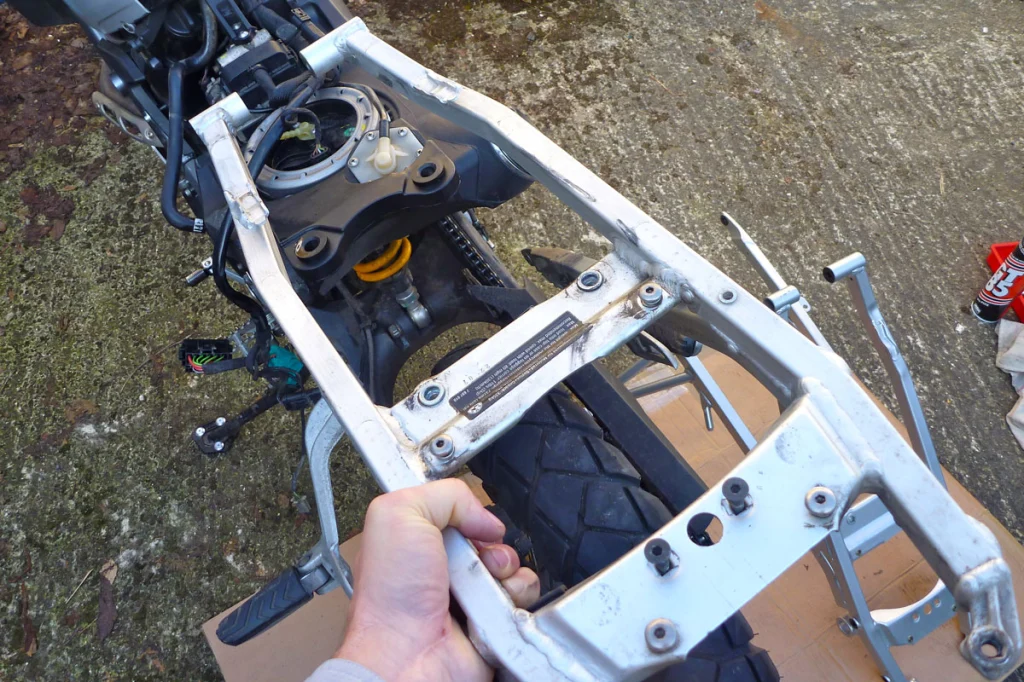
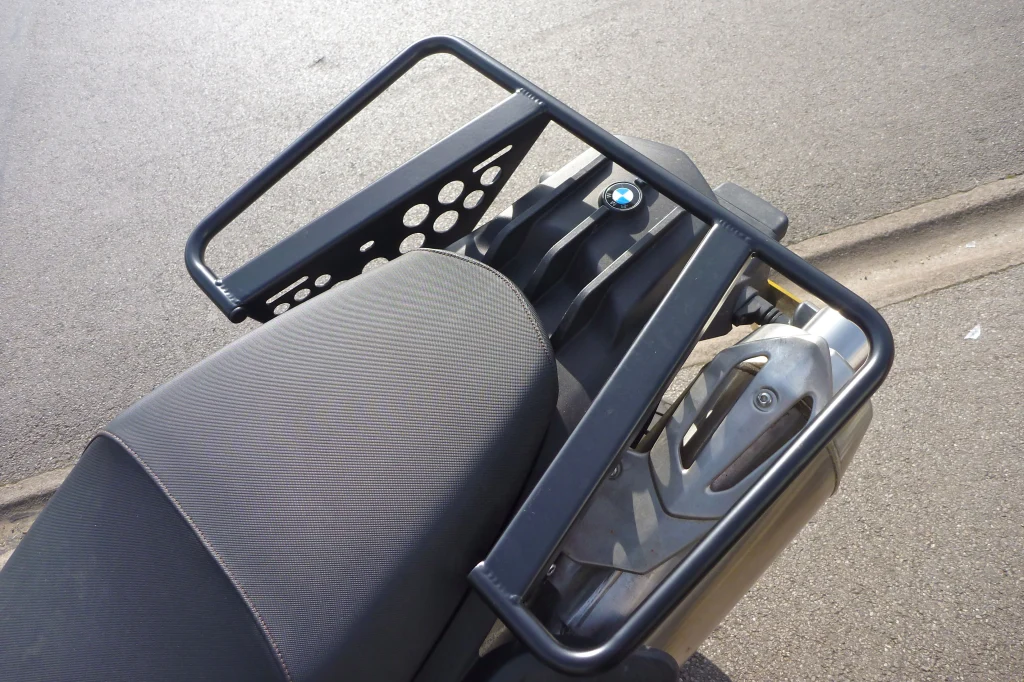
Equipment
The dashboard is about as basic as they get – just the speed reading (can be changed to kph with a bit of a faff disconnecting the battery) and a trip or odometre plus an array of colourful warning lights. I would have liked an oil or water temp gauge but didn’t go as far as fitting my Trail Tech gadget. A fuel light comes on with about 2 litres or 40km left in the main tank.
The speedo was typically 8% over compared to a GPS read-out, but the odometer (used for mpg calcs) was spot on over 100 true ground kilometres. No tools came with the bike and even if they had, they’re probably not enough to be useful, as is the trend these days.
Durability and problems
With BMW’s reputation of late, initially I didn’t feel so confident in this bike. Using it as a tour support vehicle you can’t take chances. One time in Wales the ignition didn’t come on with the key, but switching on and off again fixed that and it never happened again. When did that last happen with a Jap bike? The coolant level drop proved to be a one-off anomaly and in fact the XCo took its month and 4000 miles in Morocco in its stride.
I sold that bike feeling a lot more confident about it than when I bought it. A better gear change and smoother running would have made it much easier to live with, but the answer to that may be just round the corner.




